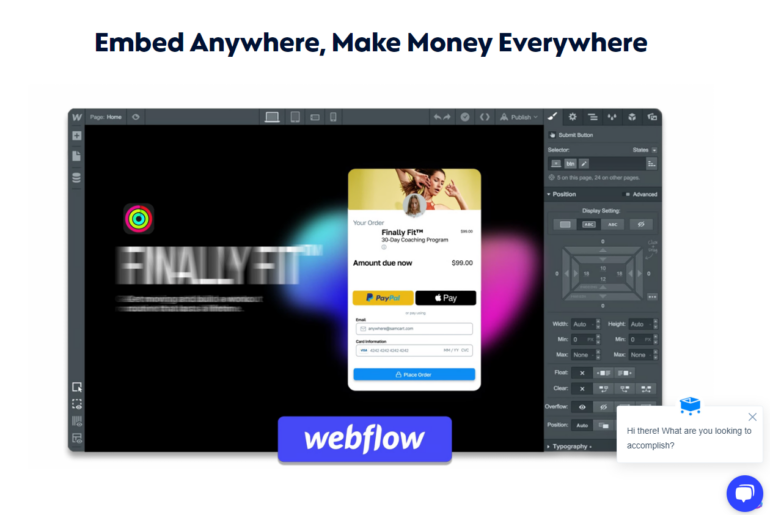RingCentral and Zoom are two of the most powerful business communication tools today.
While both apps have similar capabilities, they have distinct qualities and features that you should consider before making a final choice. In this head-to-head comparison, we dig deeper into RingCentral vs Zoom to help you find the best video conferencing platform for your team.
RingCentral vs Zoom Overview
Before we dive deeper into how the two platforms compare in various aspects, let us first see what these platforms are, who uses them, and how they work.
What Is RingCentral?
RingCentral is a cloud phone solution and collaboration company founded in 1999. Data from Synergy Research Group suggests it is a market leader in the unified communication industry, owning a market share of 20 percent.
In 2020, the company’s growth rate was 41 percent, a significant increase from 27 percent in 2019. Currently, RingCentral supports nearly 3,000 companies, most of which are based in the United States.
The platform is widely used by businesses and organizations with 10 to 50 employees.
RingCentral has a unified approach to business communication and provides continuous innovation. The company’s extensive product portfolio goes beyond cloud-based communications by incorporating security and information services.
What Is Zoom?
Zoom is a cloud-based video communications software program developed in 2011 by Eric Yuan, a Chinese-American businessman and engineer. It is primarily used for video conferences, including webinars and online meetings.
According to statistics, Zoom is the world’s most popular virtual meeting platform, surpassing other conferencing platforms like Skype, Google Meet, and Microsoft Teams. In 2022, the company racked over $4 million in revenues, with a 55-percent increase year over year.
Zoom has two major products: the Zoom Meetings and Chat and the Zoom Rooms and Workspaces. They also offer a cloud phone system and hardware products across the globe.
RingCentral vs Zoom: An In-Depth Comparison
For this Zoom vs RingCentral comparison, we are going to look into the following areas:
- Video Conferencing Quality
- Interface
- Recording Features
- Collaboration
- Integrations
- Capacity
- Analytics
- Customer Support
- Pricing
- Pros and Cons
RingCentral Meetings vs Zoom: Video Conferencing Quality
Video conferencing has never been more important than it is today. When the pandemic started, and even now that things are going back to normal, many companies still rely on online communications software systems like RingCentral and Zoom for collaboration.
RingCentral boasts 99.99% uptime, 30fps HD video, HD voice, and dynamic resolution, along with its pick-up-and-go setup.
In addition, the app lets you test the live stream quality before starting the meeting. It helps ensure that you have a stable connection and allows you to troubleshoot any network issue before your meeting starts.
Another aspect of the app is that it offers multiple screen views, including speaker screen and gallery. You can switch from one viewing mode to another through the drag-and-adjust functionality.
It even provides a way to reduce background noise to enhance users’ audio experience.
Meanwhile, the easy-to-use interface is very refreshing. Even first-time users are likely to get their way around the system easily, whether using the browser, mobile, or desktop version of the app.
Similar to RingCentral, Zoom meetings also feature 30fps video and reliable streaming performance. However, it has an advantage over RingCentral in terms of multiple screen views as it can support up to 49 active screens while RingCentral only supports up to 16.
Moreover, the Zoom app allows users to apply multiple video filters to enhance their appearance on the video. Similarly, the app carries an active speaker view, a click-and-drag adjustable view, and gallery views.
Apart from these, it has a “touch up my appearance” feature which allows you to adjust the video quality to adapt to low lighting.
Winner: Zoom
Primarily designed for video conferencing, Zoom has features that make online meetings a breeze.
RingCentral Meetings vs Zoom: User Interface
Zoom recently redesigned its UI, allowing the app to provide the same consistent experience on various devices.
In particular, they expanded the Zoom Rooms to support a growing number of devices, from small to medium and large screens. They even have landscape and portrait mode orientations.
Generally, the Zoom app is straightforward to navigate and use, making it a great platform for business and personal use.
Like Zoom, RingCentral features a user-friendly interface and is relatively intuitive for VoIP. The UI is very straightforward, allowing you to navigate all features and project documents at your fingertips.
Adding to the intuitiveness of RingCentral are the task management and note-taking features that enhance user experience.
Winner: RingCentral
RingCentral has an excellent user interface that makes it easy for the host and participants to collaborate.
RingCentral Meetings vs Zoom: Recording Features
The ability to record is crucial to online meetings as it provides reference, especially for important conversations. Both Zoom and RingCentral allow recording.
However, they differ in several aspects.
One is the length of the recordings. With its free version, RingCentral lets you record meetings for up to 40 minutes.
If you need more bandwidth, you should check out their premium plan that allows you to record unlimited session times. However, meeting recordings are automatically deleted after a year.
Similar to RingCentral, Zoom’s basic plan package has a 40-minute time limit for both desktop and mobile and unlimited time for the paid version. However, for the free version, you must store the recording locally on your device.
If you wish to upload the file to a cloud, you must get the paid version.
Along with recording meetings, the Zoom app automatically stores a meeting log, which is available for download for iOS and Android devices. Plus, it features an auto-transcription of audio and the ability to record audio-only.
It can also record private and group chat messages, something that RingCentral can’t. Nonetheless, RingCentral allows you to send meeting highlights and snippets.
Winner: Zoom
Zoom has superior meeting recording capabilities. The addition of auto-transcription and automatic logging is also beneficial for most teams.
Zoom vs RingCentral: Collaboration
Both Zoom and RingCentral are collaboration solutions that allow you to facilitate smooth team communication.
Let’s first discuss Zoom collaboration features. To start, Zoom is the only video conferencing tool that lets you share-screen a video clip with audio which is extremely helpful for presentations.
Another unique Zoom feature is the ability to share your entire mobile screen or any app. It is a massive functionality that is useful for anyone working on an app or trying to demo an app on their phone.
In line with screen-sharing, you and your fellow participants can co-annotate the shared feed on their devices.
As such, they can use lines, highlighter, arrows, and other indicators on their screens, thereby not affecting your presentation. Moreover, Zoom Meetings have an integrated chatroom where you can send direct and team-wide messages.
You can tag and mention people in the meeting, share screen captures, upload files, and use emojis on the app. If you’re using Zoom on multiple devices, private and group chat messages are automatically synced across all of them.
As for RingCentral, the app has screen-sharing and remote access functionality. It also has a chat tool similar to Zoom, where you can send public and private messages.
On top of these, RingCentral lets you create message threads and search message history.
In addition, the RingCentral app comes with a note-taking tool that allows users to see and share notes with other meeting participants.
Another unique feature of this platform is the built-in task manager that lets you create and assign tasks to your team members and keep track of them. It even provides a checklist to show all completed tasks of individual members.
Winner: RingCentral
RingCentral has useful collaborative features that facilitate smooth and interactive meetings with follow-ups.
RingCentral Meetings vs Zoom: Integrations
Both RingCentral and Zoom Meetings support a wide range of MVP integrations. RingCentral supports the integration of Microsoft Outlook, Google, Skype for Business, and Cloud PBX for Microsoft Teams.
It also supports sales and customer support applications, such as Salesforce, Oracle Sales Cloud, Zendesk, and ServiceNow. Moreover, RingCentral integrates with cloud and storage services like Dropbox and Box.
However, Zoom provides more integration capabilities than RingCentral. Through Zapier, you can connect your Zoom app to over 5,000 apps, including the most popular project management software like Slack, Dropbox, Asana, and Shopify.
You can integrate with third-party vendors to simplify workflows.
Downloadable plugins include Google Chrome extension, Firefox add-on, Skype for Business, and Outlook Web Add-in. You’ll find many integrations available in the Zoom Marketplace.
Winner: Zoom
Obviously, Zoom excels in this area. With so many apps to choose from, the Zoom app makes working and collaborating a lot easier.
Zoom Phone vs RingCentral: Capacity
Most video calling platforms cater to one-on-one calls or small group chats. RingCentral and Zoom can accommodate a larger audience, which makes them ideal for business use.
The free and Pro Zoom plans can host up to 100 participants in a single meeting. Meanwhile, the Business Plan and Enterprise Plan can hold up to 300 and 500 participants, respectively.
On the other hand, RingCentral’s Standard plan supports meetings with up to 100 participants, while the Premium plan supports up to 200 people.
Winner: Zoom
Clearly, Zoom wins in this aspect. This app is a good option if you often hold large meetings or webinars. All the tiered plans come with video, audio, and screen-sharing features.
Zoom vs RingCentral: Analytics
Measuring engagement in online meetings can be challenging. Thankfully, both RingCentral and Zoom are equipped with analytics and reporting features that help you keep track of attendance and participation.
As for RingCentral, the app lets you create a detailed report on attendance, participant duration, and activities during a meeting. This information benefits managers and team facilitators in terms of enhancing meeting efficacy and participation.
Meanwhile, Zoom has a dedicated reporting dashboard that gives administrators a look at all stats in real-time, including the top users, top geographic locations by users, usage by meeting, and more. They can see who’s hosting the meeting in real-time and the features being used like audio and video-sharing.
Additionally, Zoom lets you view historical data on meetings in customized periods under the Usage Report. Here, you can get a daily report of meetings, participants, and users, as well as meeting minutes.
A subset of reporting is the Webinar Reports which cover attendee count, QA, and Polling. Lastly, Zoom features real-time in-meeting monitoring of your CPU usage, memory, audio, video and screen sharing, and other hardware components.
Winner: Zoom
Zoom offers comprehensive reporting and analytics that give meaningful insights to meeting administrators.
RingCentral vs Zoom: Security
Security is a major factor to consider when choosing a video conferencing and collaboration platform, especially if you’re discussing sensitive or confidential information in your meetings.
You might be wondering, how secure are RingCentral and Zoom?
Today, Zoom provides stringent security measures. The company has addressed the major security gaps that were reported in the past.
First of all, Zoom offers several tools to protect your meetings. For instance, all Zoom chats have end-to-end encryption and multi-factor authentication.
In addition, meeting hosts have capabilities such as:
- Locking a meeting
- Suspending participant activities
- Securing a meeting with encryption
- Disabling and enabling participants to record
- Using a passcode for meetings
- Temporarily pausing screen-sharing when a window is open
Similar to Zoom, RingCentral also uses TLS encryption to facilitate secure communications.
The app has security settings that you can configure based on your needs. You can even take control of your content and download and delete them on your terms.
Here’s a rundown of the security features of RingCentral:
- Assign roles and permissions, and limit access to some users
- Enable users to sign in automatically to the platform using their Azure AD accounts
- Active Allow/Block feature to manage or control external communications
- Lock a meeting
- Control who can join a meeting
- Disable recording
- Require a meeting password
- Enforce a waiting room
- Enable end-to-end encryption so no one can eavesdrop on your meetings
- Download and delete video recordings, call logs, transcripts, and other files and documents
- Enable or disable automatic call recording
- Track the apps connected to your account
Winner: Tie
Zoom and RingCentral provide reliable security features that protect you and your organization from any information leaks and hacking issues.
RingCentral vs Zoom: Customer Support
Zoom provides customer support via live chat and email. They also provide telephone support for Business, Enterprise, Education, and API plans.
In addition, Zoom has a Help Center where you can find articles and additional resources on how to use the platform and resolve technical issues.
RingCentral provides customer support via phone and chat, regardless of your plan. You can also access their website’s knowledge base documents, videos, and articles.
Winner: RingCentral
RingCentral offers stellar customer support. They have a very responsive chat and telephone lines should you experience any technical problems.
While Zoom does have quality customer service, you can only access the phone support if you have a Business or Enterprise package.
RingCentral vs Zoom: Pricing
Now let us discuss RingCentral vs Zoom pricing, which is a very important consideration when choosing a platform for video conferencing calls.
RingCentral has four paid packages:
| Plan | Price | Features |
| Essentials | $19.99 a month | Unlimited phone callsTeam messagingReporting |
| Standard | $27.99 per user, per month | Essential features plus fax, video conferencing calls, and analytics |
| Premium | $34 per user, per month | Standard features plus large video meetings, multi-site administration, and custom integrations |
| Ultimate | $49.99 per user, per month | Everything in the Premium version plus device status alerts, unlimited storage, and advanced reporting |
Zoom also has four packages:
| Plan | Price | Features |
| Free | $0 | Up to 40 minutes of session per meetingSupports up to 100 participants |
| Basic | $89 per user, per year | Up to 100 meeting participantsUnlimited meetings for up to 60 minutesDirect and group messagingChat and document sharingThree editable boards with 25MB of cloud storage |
| Pro | $149 per year, per user | All the features of the basic account plus three whiteboards and 5GB of cloud storage |
| Business | $199 per year, per user | Supports up to 300 attendeesunlimited whiteboards, messaging features, and 5GB of storage |
Winner: Zoom
Zoom gives RingCentral a run for the money in terms of value. Obviously, Zoom is more affordable.
Take note that Zoom Meetings are limited to video conferencing calls. If you want to add a phone line, you will have to avail of a separate service that starts at $10 per month.
RingCentral vs Zoom: Pros and Cons
Choosing between these two great platforms can be overwhelming. To help you overcome the confusion, here’s a quick breakdown of the pros and cons of each call and video conferencing product:
RingCentral Pros:
- HD video quality
- No need to install for participants
- Easily scalable
- User-friendly and intuitive interface
- Excellent messaging features
- Integrations with apps like Microsoft and Google Workspace
RingCentral Cons:
- Too many updates
- Plans are very expensive
Zoom Pros:
- Affordable packages
- Can host large meetings and webinars
- HD-quality video
- Easy group call and conferencing features
- Smooth integration with numerous apps
Zoom Cons:
- All users, including participants, need to download the app
- Comes with many subscriptions and add-ons
Zoom vs RingCentral Meetings: Making the Choice
The main difference between Zoom vs RingCentral is that the latter is a voice-first platform, while the former is a video-first platform. Both of them are excellent tools for business communication.
Choosing the right platform for your team boils down to understanding your communications needs and budget. If you’re a big organization that regularly holds large video conferences and meetings, you’re better off with Zoom.
On the other hand, RingCentral makes an excellent choice if you’re a small business and prefer a telephone system with video conferencing capabilities.
Zoom vs RingCentral FAQs
Do you want to know more about Zoom vs Ringcentral? Here are answers to common questions about them.
1. Zoom phone vs RingCentral, what’s the difference?
While Zoom is best known as a video conferencing platform, the company also offers a VoIP phone system for businesses of all sizes.
Their phone service rates start at $120 per user per year. This plan includes advanced phone features, including domestic SMS and MMS, and extension to extension outbound calling.
RingCentral is popular for its VoIP cloud system, including fax, text, and audio conferencing. Phones are included in all their packages, unlike in Zoom, where you must pay for a separate service in case you want to have a phone line.
2. Zoom vs RingCentral meetings, which is better?
If you’re hosting audio-only meetings, RingCentral makes an excellent option as it allows you to set up an audio-only call with multiple participants via any phone. However, if you prefer video conferencing, Zoom provides many more features.
While RingCentral also supports video meetings, it focuses on providing unified communications through its cloud VoIP ecosystem. On the other hand, Zoom is more focused on quick video and audio meetings.
Another difference when it comes to RingCentral meetings vs Zoom is in the way participants can join.
In Zoom, participants need to download the app before joining a meeting, whereas, in RingCentral, only the meeting host needs to download the app. The participants can join by clicking the link on their browser.
3. How do you get past the 40-minute time limit of Zoom?
You have two options when your 40 minutes run out. Your first option is to start a new meeting.
Currently, Zoom places no restrictions on the number of meetings you can host, so you can simply start a new meeting once your 40-minute time limit is up.
Your second option is to upgrade to the Pro package, which gives you unlimited time slots.
4. Is RingCentral owned by Zoom?
No, but the two entered into a partnership in 2013 until 2018. During that time, RingCentral’s video conferencing feature was powered by Zoom.
In 2020, RingCentral launched its video-conferencing software called RingCentral Meetings.
5. What’s the difference between RingCentral and RingCentral Meetings?
RingCentral is a cloud-based VoIP system that enables you to host audio-only calls. RingCentral Meetings is an app that provides video-conferencing capabilities, including screen-sharing and private and group chat.






